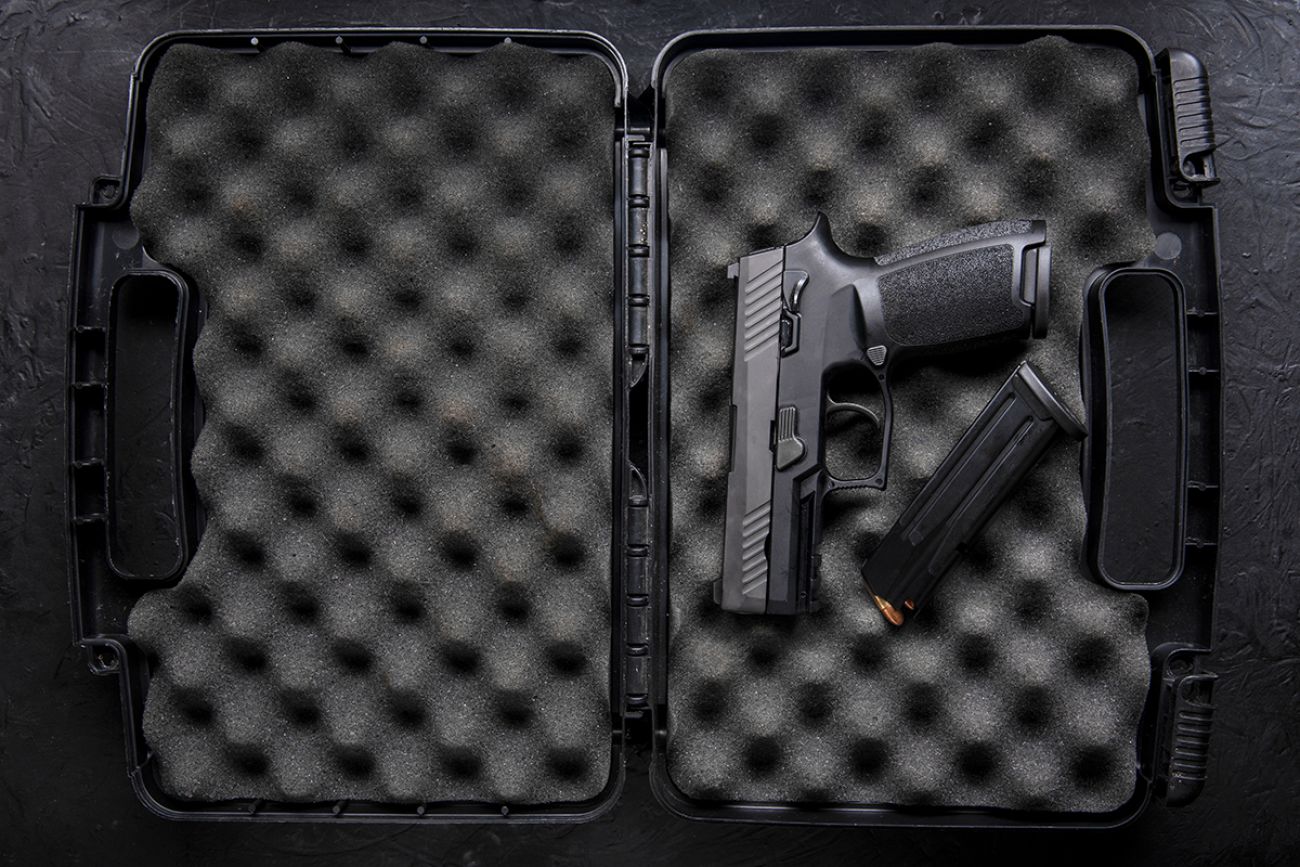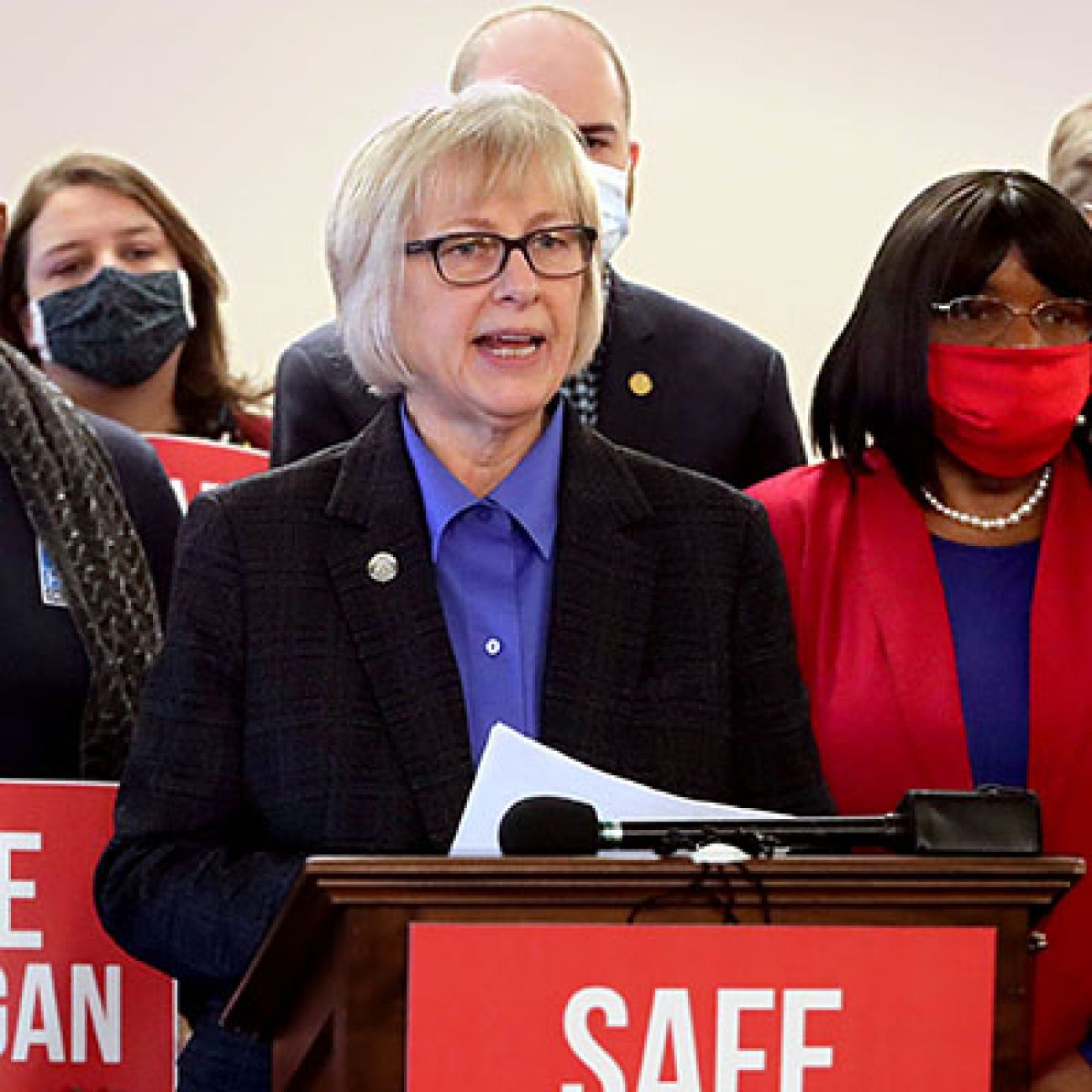Gun control a priority for Michigan Democrats. What studies say about reforms.

- Michigan Democrats plan to push gun reform measures like universal background checks, safe storage and red flag laws
- Most studies show safe storage laws work to reduce gun-related deaths, injuries; research in other areas is less conclusive
- A lack of funding for decades has discouraged research into gun control
Dec. 16: Dana Nessel to Michigan Democrats: Ban concealed guns at state Capitol
LANSING — For almost two years, Michigan Sen. Rosemary Bayer’s bills to restrict gun access stalled in legislative committees controlled by Republicans.
But next year, the Beverly Hills Democrat has a real chance to carry them to the finish line.
Following a historic showing in the November election, Michigan Democrats will control both chambers in the state Legislature come January for the first time since the 1980s. One of the priorities, Democrats including Gov. Gretchen Whitmer say, is stricter laws about gun access.
Related:
- How Gov. Gretchen Whitmer, Democrats plan to cut Michigan taxes in 2023
- Michigan schools race to increase safety through high tech, mental health
- Right-to-Work battle looms in Michigan: Businesses fear repeal by Democrats
- Michigan takes steps to boost bed capacity for kids in mental health crisis
“We believe there are legislative solutions that we can do to make a big impact in reducing gun violence,” incoming Senate Majority Leader Winnie Brinks, D-Grand Rapids, told Bridge Michigan. “I anticipate that we will have some really good conversations with folks across the aisle.”
Bayer last week told Bridge Michigan that Democrats will likely prioritize three areas of gun reform: universal background checks, safe storage laws with a focus on keeping guns out of the hands of children and “red flag” laws, which would allow someone’s gun to be taken away temporarily if they are deemed dangerous to themselves or others.

The push in Michigan follows last year’s shooting at Oxford High School and comes as a wave of states adopt gun reform measures. They’re motivated by a rise in mass shootings: Of the 172 from 1966 and 2019, more than half have been since 2000 ,and 20 percent were from 2010 and 2019, according to The Violence Project, funded by the U.S. Justice Department.
In recent months, California prohibited gun sellers from marketing products to minors and restricted “ghost guns” — privately assembled guns that are not traceable — while Delaware strengthened background checks and regulated high-capacity magazines and Vermont banned guns from hospitals and the transfer of firearms between unlicensed people.
What happens after states pass these laws?
Bridge Michigan reviewed more than 20 studies on safe storage, red flag laws and universal background check laws. Most studies indicate such laws help reduce gun-related injuries and deaths, but some scholars contend more time and data are needed to make conclusions.
Both sides of the debate can find studies to back up their bias. That’s because “research has been limited by lack of funding and data,” the U.S. Government Accountability Office noted in a 2017 report.
The 1996 Dickey Amendment — pushed by the National Rifle Association — essentially banned the Centers for Disease Control and Prevention from funding gun violence research, said April Zeoli, policy core director of the Institute for Firearm Injury Prevention at the University of Michigan.
A 2019 deal in Congress allowed federal funding again to research gun violence, allocating $25 million per year. The money is split between the Centers for Disease Control and Prevention and the National Institutes of Health.
“There is a lack of evidence-based (research) by design,” Zeoli said.
The political arguments are well-known, and polling suggests support for gun control is increasing. A 2019 Pew Research Center survey found 60 percent support more laws and, despite sharp partisan divides, support is increasing among both Democrats and Republicans.
Democrats contend tragedies like Oxford could be prevented if laws were in place to require safe storage to prevent child access to guns. Republicans have blocked the effort, arguing such measures could infringe on gun rights and instead proposing legislation to eliminate penalties for carrying pistols without a concealed weapons permit or registration.
Outgoing House Speaker Jason Wentworth, R-Farwell, assembled a bipartisan task force to address school safety. It recommended expanding mental health services and improving building security, but stopped short of reaching a consensus on any gun-related bills. Task force co-chair Rep. Scott VanSingel, R-Grant, previously said there is support among some Republicans for red flag and safe storage laws.
Here’s a look at the state of gun ownership and gun deaths in Michigan and nationwide, the three major reforms pushed by Democrats, and what research says about their effectiveness.
Guns in Michigan and America
Roughly 30 percent of American adults identify as gun owners and 40 percent report living with someone who owns a gun, according to surveys from the Pew Research Center and Gallup.
In April 2021, 30 million American children lived in households with firearms, and 4.6 million children — roughly 1 in six 6 lived with gun owners — stayed in homes with loaded and unlocked firearms, according to a February 2022 study of the 2021 National Firearm Survey results.
Unsecured firearms are the main source of weapons in most school shootings committed by children nationwide, according to a Washington Post analysis. Of all the 105 shootings between 1999 and 2019, where the source of the weapon had been publicly identified, killers accessed the gun they used to shoot from their family members or friends 80 percent of the time.
There is no official data about guns in Michigan. But a 2020 RAND Corp. survey estimates that, between 1982 and 2016, an average of 40.2 percent of Michigan adults say they have at least one gun.
Guns are the leading weapon used in both suicides and homicides in Michigan.
Gun-related suicides made up 53 percent of all 44,834 suicides in 2020, according to a state report. Between 2014 and 2018, almost 75 percent of all homicide victims were killed by a firearm, according to data from the state’s violent death reporting system.
An average of 89 children and teenagers in Michigan die by guns every year, and 52 percent of those deaths are homicides, according to the state.
Safe storage and child access prevention laws
What are they?
While often used interchangeably, safe storage laws and child access prevention laws are different, according to Allison Anderman, senior counsel and director of local policy at the Giffords Law Center to Prevent Gun Violence, a nonprofit advocating for gun control.
Safe storage laws often mandate that gun owners store their weapons in a safe manner, Anderman said. Child access prevention laws generally impose criminal penalties on gun owners if a child could — or does — have access to their guns and they “know or reasonably should know” of the possibility, according to the Giffords Law Center.
At least 30 states and Washington, D.C. have child access prevention laws, the Washington Post reported last year. Eight states, along with D.C., have safe storage laws mandating secure gun storage, according to pro-gun control group Everytown for Gun Safety.
What Democrats want to do in Michigan
Bayer told Bridge she is working with groups such as the Giffords Law Center and Brady’s Law Center to perfect the bill language. But proposals next year would be similar to the gun control bills introduced in the past years.
The most recent safe storage packages — Senate Bills 550-553 and House Bills 5066-5069 — would require gun owners to secure the gun in a locking device or keep it “in a location that a reasonable person would believe is secure” — language that is similar to the safe storage law Connecticut passed in 2019.
Gun owners who fail to do that would be punishable by up to five years in prison if a minor uses the gun to injure or kill anybody, including themselves. The bill would have applied to parents of the teen gunman who shot up Oxford High School.
The teen claims the gun used in the massacre was unlocked and a Christmas present from his parents. They face involuntary manslaughter charges on allegations they ignored warning signs that could have prevented the shooting.
“Firearm safety devices” would be exempt from the state’s 6-percent sales and use tax, reducing the financial burden on gun owners, according to the bills.
Do the laws work?
Most researchers found such laws reduce gun-related injuries, suicides or homicides, according to more than a dozen studies reviewed by Bridge.
But the degree of impact varies, and scholars have argued weak penalties and a lack of enforcement reduces the laws’ effectiveness.
First, most studies showed gun prevalence is linked to high risks of firearm-related deaths.
A 2020 study of school shooting data from the Washington Post concluded that “more permissive firearm laws and higher rates of gun ownership were associated with higher rates of both school shootings and active school shootings after controlling for critical covariates.”
Research has found that restricting access of children to guns helps reduce firearm suicides or gun-related deaths in general, researchers found:
- Child access prevention laws across 18 states were linked to “a modest reduction in suicide rates” among teenagers, according to a 2004 study that analyzed all youth suicides between 1976 and 2001.
- A September 2020 study, which analyzed suicide data, gun ownership and states’ implementation of child access prevention laws between 1991 and 2017, also associates safe storage laws with decreased adolescent firearm suicide.
- A 2019 study of firearm ownership and suicide data in 2015 estimated that safe storage laws or recommendations that parents store their guns safely could prevent “up to 32% of firearm deaths.”
But other studies found child access laws don’t always work. A 2000 study shows child access laws only helped significantly reduce unintentional firearm deaths in Florida — not the 14 other states with similar laws.
There are very few studies examining safe storage laws and school shooting deaths.
A 2016 study found little evidence suggesting child access prevention laws would reduce school shooting deaths by minors, but the study found the laws are associated with declines in gun carrying on campus and reports of firearm threats in school.
John Lott — founder of the nonprofit Crime Prevention Research Center, critic of gun control legislation and author of books including “More Guns, Less Crime,” — co-authored a 2001 study that found no evidence safe storage laws decrease juvenile accidental gun deaths or suicides.
Lott’s findings and methodology has been criticized by many researchers, but he has in turn argued those scholars’ methods have flaws.
“Safe-storage laws increase violent and property crimes against low-risk citizens with no observable offsetting benefit in terms of reduced accidents or suicides,” concluded the study from Lott, who is a Detroit native,
Red flag laws
What are they?
“Red flag laws” is a term used to refer to extreme risk protection orders. They are laws that allow a judge to order temporary removal of someone’s gun if the judge believes they would use it to hurt others or themselves.
In all, 19 states and Washington, D.C. have such laws. The first one to do so was Connecticut in 1999. Indiana followed in 2005, passing Jake Laird’s Law to honor a police officer who was shot and killed by a man suffering from mental health disorders.
Despite wide implementation, red flag laws are rarely enforced even as gun deaths soared. The Associated Press found that those laws had been used 15,049 times across the nation to remove firearms from people since 2020 — fewer than 10 per 100,000 adult residents.
The law was mostly used in Florida, Illinois and California, the analysis found.
What would Michigan’s law look like?
The state senator, Bayer, said proposed red flag laws in Michigan would allow family members of the person they deem a danger to themselves or others to call the police, and law enforcement would have the authority to temporarily take away that person’s gun for three days while they wait for a hearing.
Following the hearing, a judge would have the power to order temporary removal of the gun for up to a year, she said.
Bayer said the bill, if passed into law, must go hand in hand with police training on how to deal with mental health crises and enhanced penalties for people who file a false report with the police.
Do the red flag laws work?
It’s hard to say because there’s not enough research.
That’s partly because of the lack of federal funding and how new the laws are, Zeoli, the UM researcher, noted.
Among existing studies, some showed red flag laws could reduce gun-related suicides and mass shootings:
- One published in 2021 on red flag laws across the states between 1990 and 2018 found such laws significantly decreased firearm suicides, but did not have the same impact on firearm homicides.
- Another study, conducted by Zeoli in collaboration with the Johns Hopkins Bloomberg School of Public Health, found red flag laws help prevent mass shootings. They analyzed 6,500 extreme risk protection order cases from six states, 10 percent of which were petitions for orders in response to a mass shooting threat.
Zeoli told Bridge she is also working on another study on the impact of red flag laws on firearm-related suicides. Results have not been published yet, she said, but preliminary results seem “promising.”
The legislation is controversial among scholars studying its impact.
Initial results from a study in Montana found red flag laws in the state could have led to reduction in firearm homicides. But the study ultimately cautioned “these laws are likely a symptom rather than the cause of decreased rates of firearm suicide and firearm homicide.”
Some studies have urged policymakers to tread with caution when designing red flag laws, arguing it is possible to infringe on a gun holder’s constitutional right to bear arms.
But other experts argue in their research the law can still be implemented without conflicting with one’s Second Amendment rights.
Lott, the researcher frequently cited by gun rights advocates, told Bridge that it’s often public health academics — not criminologists or economists — who disagree with his findings. In a 2019 study he co-authored, Lott argued red flag laws had “no significant effect on either homicide or suicide” in both Connecticut and Indiana.
Universal background checks
What are they?
Federal law requires background checks for anyone who buys a gun through a federally licensed gun dealer and bars people with a criminal record or otherwise ineligible to own a gun from buying firearms.
Since the requirements were established in 1998, more than 300 million checks have been conducted and more than 1.5 million have been denied, according to the Federal Bureau of Investigations.
But only 40 percent of guns sold in America are sold through a federally licensed dealer.
A total of 13 states and D.C. have universal background check laws, which generally require that all firearm sales go through licensed gun dealers who can perform background checks on their buyers before sale.
What could Michigan’s law look like?
Michigan Democrats have sponsored universal background checks last year, Senate Bills 454-456 and House Bills 4869-4871, that would apply a licensing process only required for pistols to all kinds of firearms. They would also expand the penalties for lying on a pistol license application to lying on applications for any firearm.
Do the laws work?
Research has shown universal background checks can reduce gun violence, but there is no consensus on how well they work.
A 2019 study of all 50 states over a 26-year period linked universal background checks to a 14.9 percent reduction in overall homicide rates.
A 2015 study on Connecticut’s law requiring gun buyers to obtain a permit, which comes with background check requirements, was linked to a 40% reduction in the state’s gun-related homicides during the first 10 years since it was implemented in 1995.
Another 2015 analysis of past studies indicates expanding some background checks — the kinds that would disqualify people from illegally accessing firearms — could “have protective effects against lethal violence.” And criminals who attempt to buy a gun from licensed dealers yet are denied are less likely to engage in violent crimes, the study concluded.
See what new members are saying about why they donated to Bridge Michigan:
- “In order for this information to be accurate and unbiased it must be underwritten by its readers, not by special interests.” - Larry S.
- “Not many other media sources report on the topics Bridge does.” - Susan B.
- “Your journalism is outstanding and rare these days.” - Mark S.
If you want to ensure the future of nonpartisan, nonprofit Michigan journalism, please become a member today. You, too, will be asked why you donated and maybe we'll feature your quote next time!




